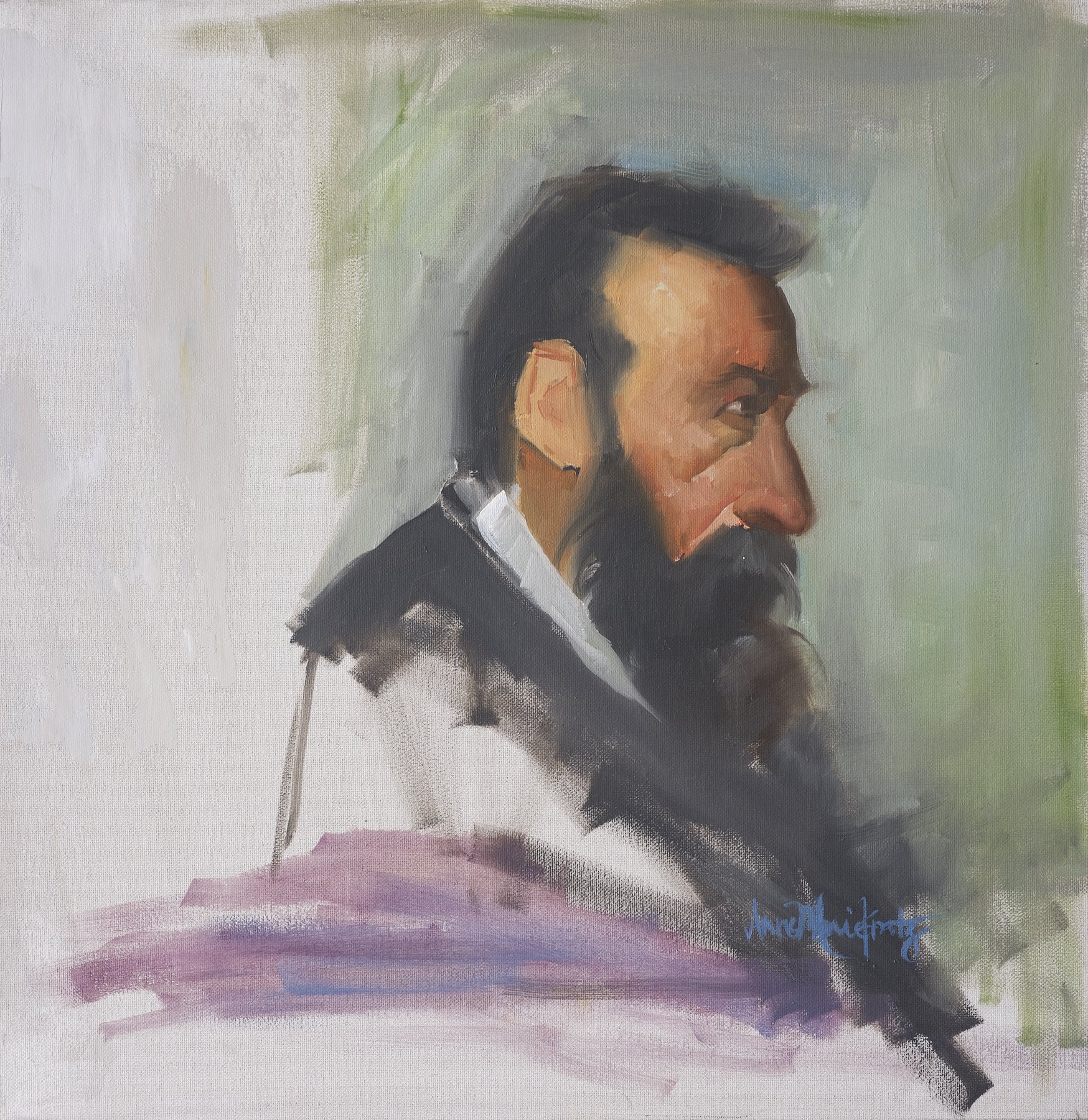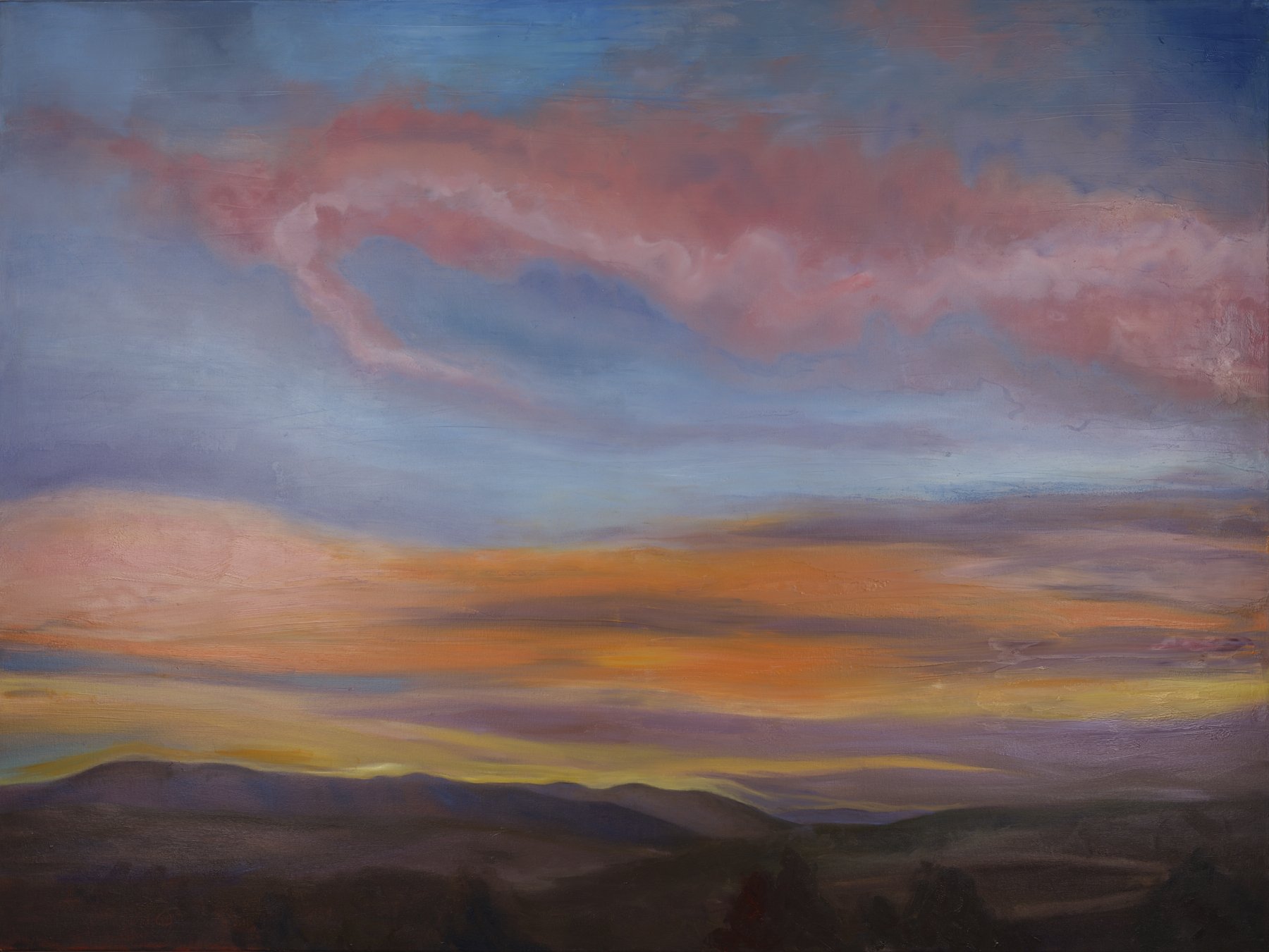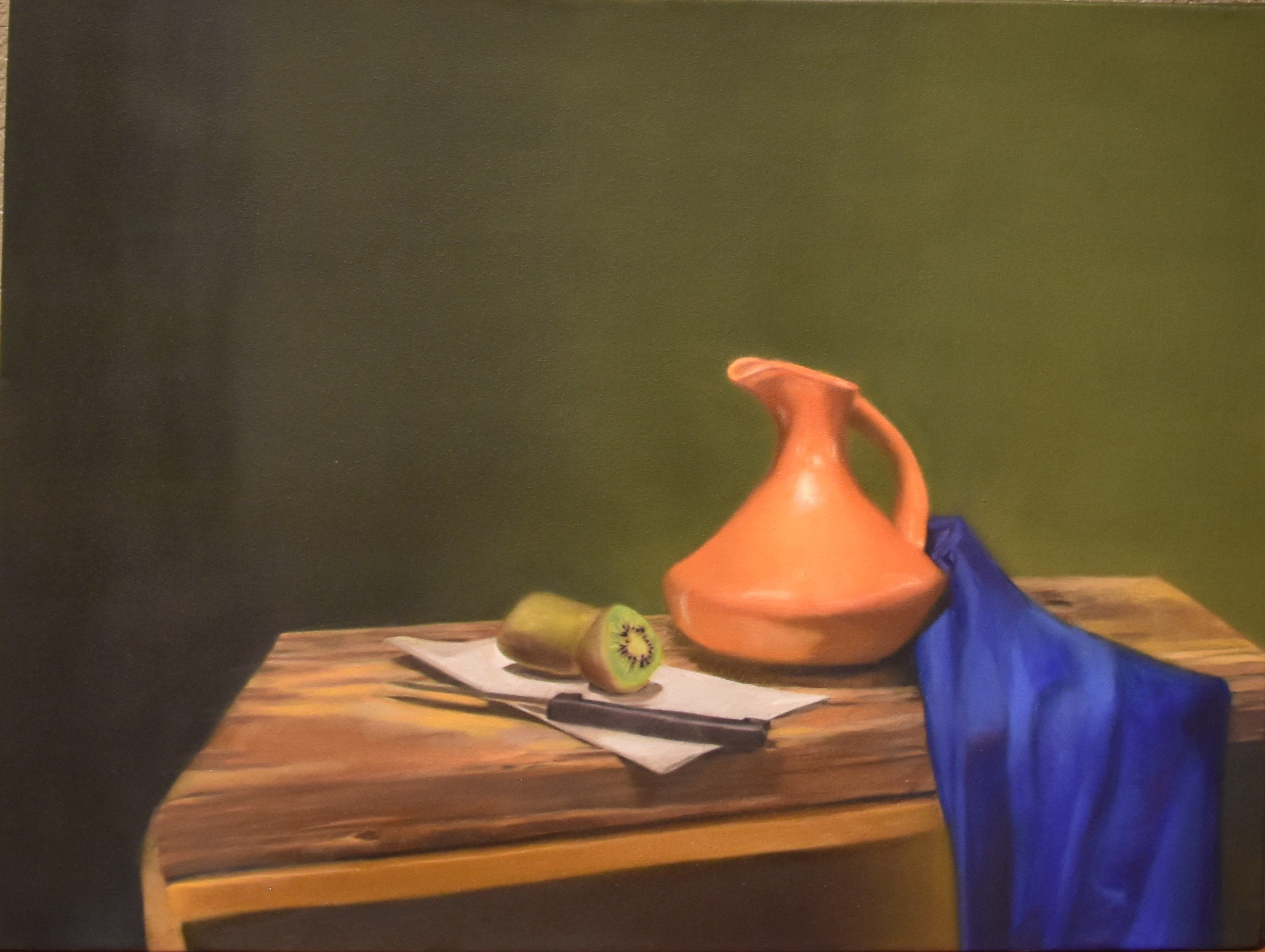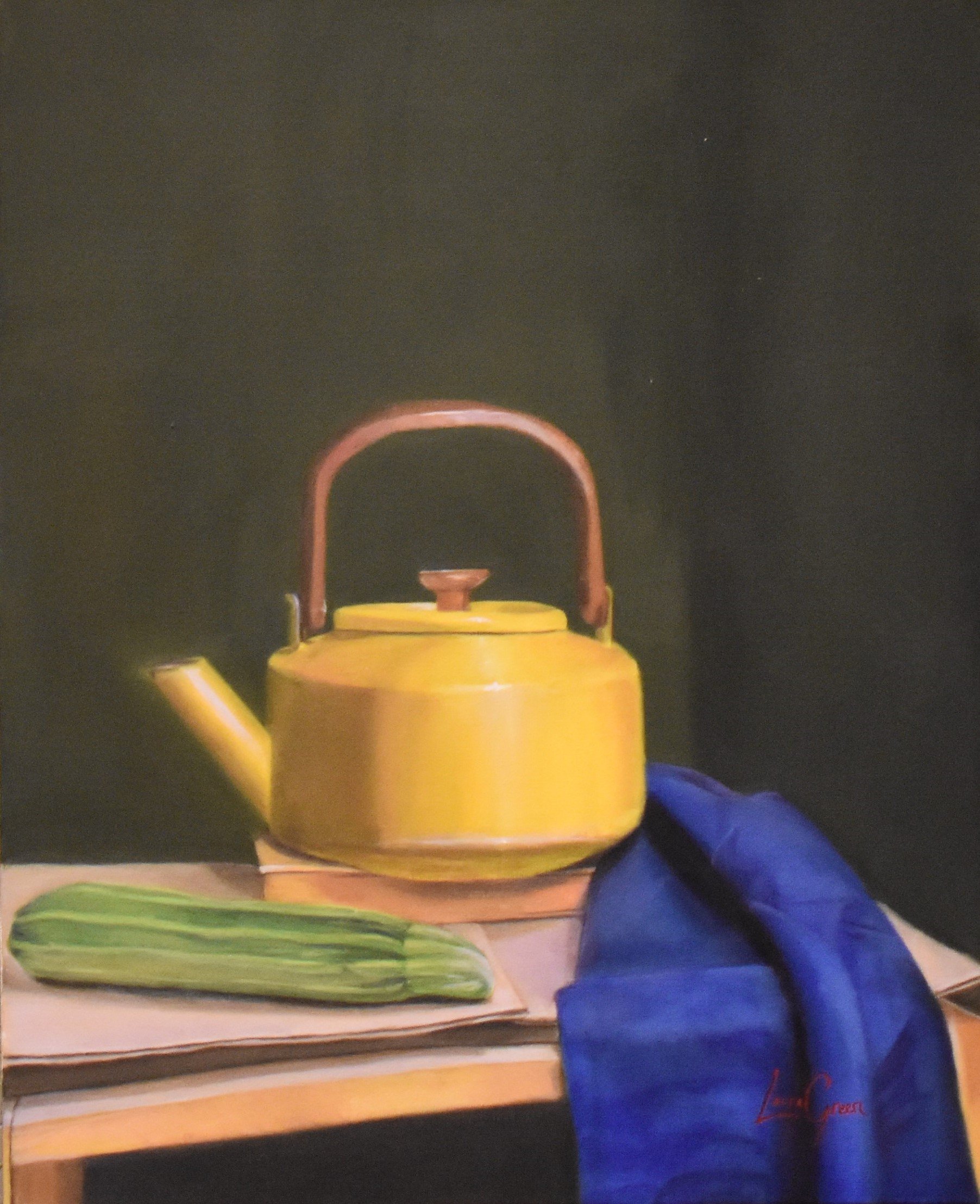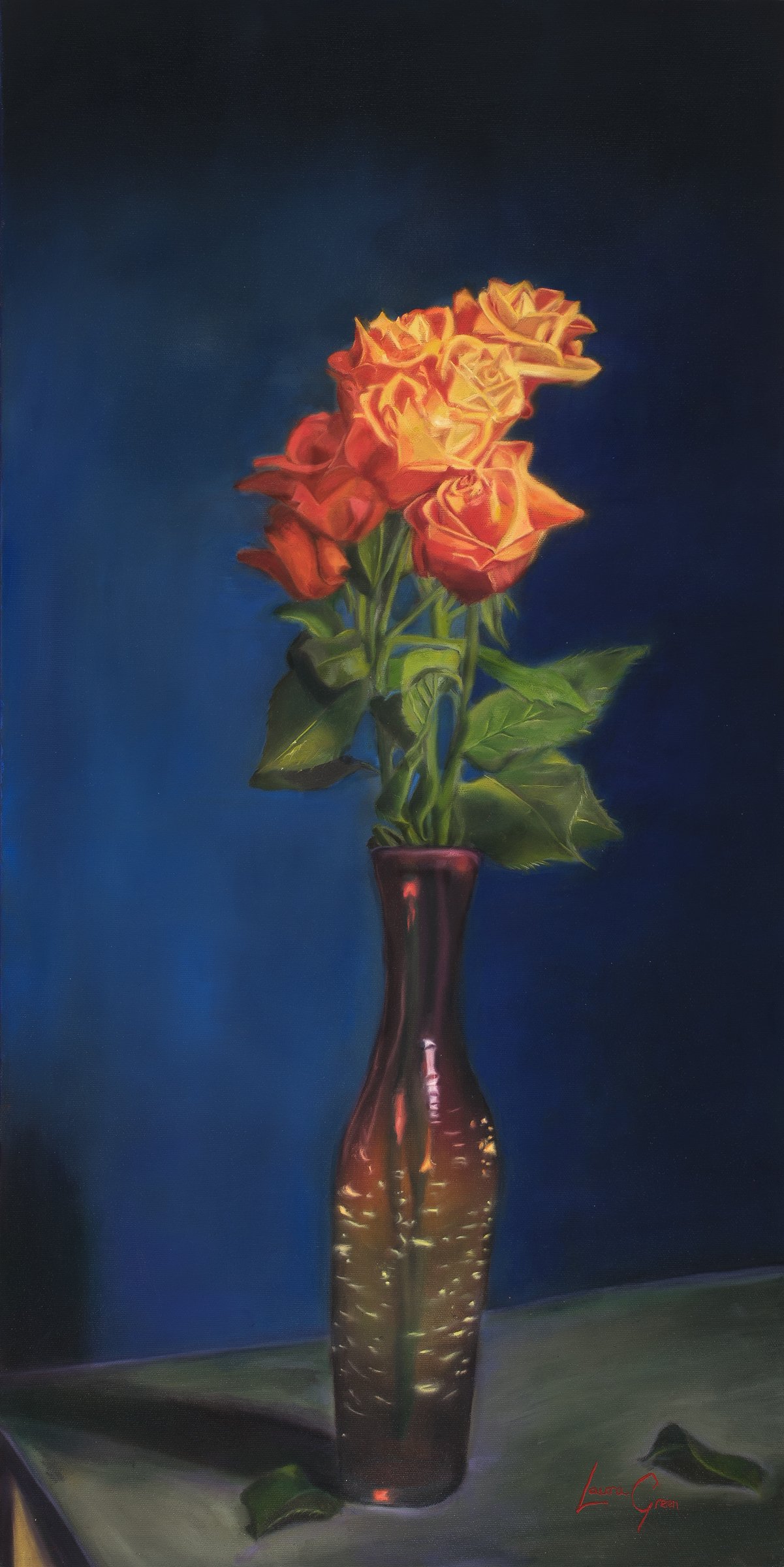Duet-Expressions in Paint by Laura Green and Anne Marie Kratz, 04/22/2022-05/22/2022
Informed by classical art training in painting both Laura Green and Anne Marie Kratz display a variety of images and color palette in this beautiful exhibit in the Santa Fe Arts District. The artists were asked to respond to some interview questions ( see below) as a way of getting to know their influence thoughts and experience.
Interview with Laura and Anne Marie
How did you get involved in your art making? LAURA: I’ve been making art as far back as I can remember and started experimenting with painting in college. After college I did commission paintings and grew my portfolio. However, I was running into the same problems in my paintings time and time again. I decided to do something about it, so I could problem solve more quickly. ANNE MARIE: I have tried to recreate what I see in the world and in my mind with clay, pencils and paint for as long as I can remember. I did not have access to formal art classes as a child because I was number 6 out of 7 children and our parents were stretched quite thin. I did, however, go to piano lessons every Monday for many years starting at age 5. I remember trying to read the words while I was actually reading and playing the music. Many times, my parents forgot about me while I waited at the piano teacher’s house (common occurrence in a large family in the 1970’s) which turned out okay for me. My piano teacher, her husband and I talked about art and music while sitting outside on their handcrafted seesaw while snacking on apples picked from a tree in their orchard. Eventually, mom or dad’s car would pull into the long driveway to take me home or on the rare occasion Zelma and her husband would drive me there.
What is your background, training, or education? LAURA: I have a bachelor’s degree in English from CSU, but I always wanted to further my studies in art. My Abuela was so disappointed when I studied English instead of fine art. She told me I should continue my studies in art, because she sensed I was an artist from the time I started talking. I was a self-taught artist until 2017, but after my Abuela passed away, I decided to honor her by taking a classical portrait class from Ali Ghassan at Art Students League of Denver. I wanted to develop my technique further in realism, so I took classes from him at Real Academy of Art. ANNE MARIE: I studied Fine Art in Graphic Design at Iowa State University. After relocating to Denver and as a perpetual learner, I took writing classes at Denver University (DU) and numerous drawing, painting and art business classes at Art Students League in Denver (ASLD). It was at ASLD that I met Ali Ghassan Al-Zobaede, my most influential instructor.
What is your source of inspiration, influence, and ideas? LAURA Most of my still lives are composed of objects that I’m personally connected to, because I must paint what I know and what I have an attachment to, so that it draws me in. Mid-Century tea kettles, glass and pottery can be seen throughout my work, because I’m drawn to the warmth and lines of these items. A Romanesco squash and tomatoes from my husband’s garden reminds me of watching him come home and tend to something that’s grounding. In turn I like to paint his harvest because I feel connected to him, and painting is what grounds me. Adjusting the lighting in the studio to make an ordinary bouquet of flowers, tea kettle, or vase extraordinary also inspires me. I also draw inspiration from my experience as a mother and the beauty and the trials I have experienced in raising my daughters. Being a mom and committing myself to simultaneously being an artist has pushed me out of my comfort zones. ANNE MARIE: Ali Ghassan, Art Renewal Center (ARC) Associate Living Master, and Founder of REAL Academy of Art Colorado, the state’s first and only art academy certified by ARC, inspired me to finally take classical visual art training seriously and to become a professional artist. I took each of his 8 week drawing/painting courses and wanted more training after that. I followed Ali Ghassan to his first school in the United States that is in the same building where the much larger and current school resides. My initial goal was to paint realistic portraits of my three kids and things have rapidly moved to where I am today. Currently, I am a founding Board member of REAL Academy of Art Colorado, Secretary of the BOD, Admissions Director and Student Liaison at REAL Academy of Art Colorado. I believe in classical visual art training and enjoy helping artists find Ali Ghassan and his school.
What artists do you admire, aspire to or like? LAURA I admire the work of my instructor at Real Academy of Art, Ali Ghassan, he is a modern day master whose contemporary works had me knocking on his atelier’s door. Seeing Daniel Sprick’s painting “Release Your Plans” at the Denver Art Museum 9 years ago had me dive into his body of work. His investigative process of finding objects for his still life to make his compositions more interesting has left a very strong impression on me. Also, the mastered techniques of the 19th century French Academic artist, William Adolphe Bouguereau is so extensive that I realize my room for growth is infinite. From there my interest in classical realism grew, and I then found the artist and author, Juliette Aristide’s book, Lessons in Classical Painting. I was lucky enough to find Real Academy Art Colorado shortly after practicing some of the methods she shares in her book. And finally, the Spanish realist painter Antonio Lopez Garcia has mastered the emotional with the technical, which I aspire to in my own work. ANNE MARIE: The drawings and portrait paintings of the Gilded Age by Mary Cassatt, John Singer Sargeant, and Cecilia Beaux speak to my love of soft yet elegant lines in sophisticated settings. Contemporary Artists Richard Schmid and Nancy Guzik have had a profound impact on my life because of their kindness, encouragement and exquisite body of work.
Can you explain how and why you use the materials you do? LAURA I work on stretched canvas, and I also stretch my own double primed linen on stretcher bars. I paint on this substrate because it withstands the tests of time. My favorite palette knife is a RGM Italian color knife in no.045. It’s one of my favorite tools I’ve come across because it effortlessly picks up oil from my palette. For brushes I’ve used many different types, but the Winsor and Newton Monarch brushes are my go-to from start to finish in my paintings. These brushes blend oils in a way that help me get my desired flat effect. I use linseed oil mixed with mineral spirits as a medium, and for oil paints I use Old Holland. Old Holland paints have an exceptional texture and flexibility that feels invigorating under my brushes. ANNE MARIE: I do enjoy putting one transparent item in a still life. The reflections are fun to see, fun to paint and are beautiful ways to study the light path which is different when under glass. I also love to mix my own black oil paint color by combining the two colors, ultramarine blue and burnt sienna.
Can you describe the process? LAURA I start my process by being an investigator on constant lookout for still life subjects. It can take me weeks to build a story for my composition, and I’ll look anywhere from antique stores to friends and family’s attics, my husband’s garden, to my favorite flower shop. I’ll then build my still life composition and from there I’ll draw it on newsprint paper with a 2b pencil. I want to be precise with my lines and proportions, so I use straight line blocking and the Bargue Method during the drawing part of my process. I then transfer the drawing onto canvas or linen and do an underpainting in burnt and raw umber oil paint. I work in layers and my second layer is done by using a thick amount of oil paint to build the forms in my painting. During the last stage I oil out my painting with one part linseed oil to one part mineral spirits. I glaze[LG1] my painting by adding a thin layer of oil paint and add fine details. This is my favorite stage of the painting because I can open up and use expressive brush strokes. ANNE MARIE: I mainly paint with oil and I sometimes use the classical painting method by first drawing the subject/s first. I then paint the underpainting with diluted thin paint to establish the values. Then, using a tiny bit of medium or after washing my canvas with linseed oil, I paint with thick paint. Brushstroke and blending are also very important while I follow the form of my painting’s subject. After this layer is dry to the touch, I move on to glazing and a few strategically placed highlights. I also love to do sketch paintings alla prima style and finish a painting in one session.
What direction do you think you might be going in your work? LAURA I want to expand my portfolio by adding figurative and landscape paintings to my body of work. ANNE MARIE : I plan to explore a much looser painting style and to work on a few impressionist pieces of the scenes from our family’s most recent trip to colorful Isla Mujeres, Mexico. I will also continue to sketch or paint daily in my studio.
[LG1]iWhat events are you involved in this year that someone might want to attend?
LAURA: I want to expand my portfolio by adding figurative and landscape paintings to my body of work. ANNE MARIE :Two of my paintings will be featured in the Colorado Artists section of Southwest Art Magazine June/July 2022 issue. I will continue my work with REAL Academy of Art Colorado where we are hosting a Figurative Painting Workshop by Juliette Aristedes, August 12-14, 2022. I plan to paint en plein air during all the warmer months in Colorado and on the beaches of Assateague Island while visiting family this Summer in Maryland. I will spend as much time as possible on the western slope of the Rocky mountains while painting outside in nature while my family and I hike, bike, golf and swim there.


